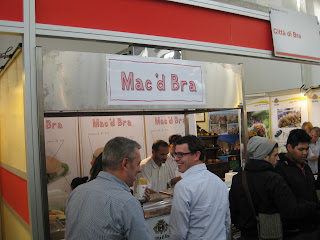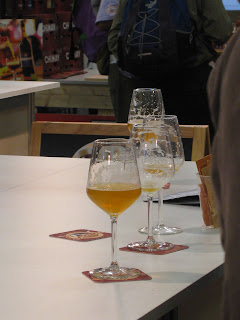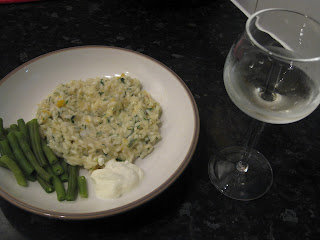Our walking tour took us
from the Tower to Spitalfields Market, via a series of sites on the boundary of
the City and the East End which are indelibly
linked with a string of brutal murders of prostitutes
that took place between August and November in 1888, shocking Victorian Britain
with their brutality and gruesomeness. The murders were described at the time
as being “unique in the history of our country” by no less a person than Sir Charles Warren,
the Commissioner of the Metropolitan Police. This was the first instance of a
serial killer at work, and coming at a time of a burgeoning sensationalist
press it gripped the nation, and indeed the wider world, like nothing before or
since.
The fact that the murderer,
known to history as Jack
the Ripper, was never caught means that the Whitechapel murders still fascinate over a century later, to the extent of being taught in some schools; when
I did my teacher training it was a special project for one of the GCSE History
classes that I taught. We were meant to go on a walking tour then but never
did. Since then, I’d always intended to go on the walk and with some friends visiting from Canada this
seemed like the ideal opportunity. We were not disappointed.
The venues may have changed
in appearance – much of this part of London
was destroyed in the Blitz – but Shaughan’s vivid descriptions and recitals of the letters apparently sent by the killer helped to bring
the events of 1888 to life.
He himself admitted that he’s had over a dozen people faint on his tours over
the years, and his gory descriptions of the state of the victims’ bodies are
not for the faint-hearted.
Shaughan told us a lot not
just about the Ripper murders but also about the history of that particular
part of London; the Whitechapel and Spitalfields areas are today a centre of
the Bangladeshi immigrant population (which is why Brick Lane is the best place
to go for a curry in London), but their proximity to the docks means that they
have always been areas of immigrant settlement, from the Huguenots in the
seventeenth century to the Eastern European Jews in the nineteenth. This was
the poorest part of London, a place where prostitution was rife; according to
Shaughan, in 1888 the going rate for sex was the same as the price of a place
to sleep in one of the area’s many doss-houses (fourpence), one could purchase
enough gin to get drunk on for a penny and there were streets where policemen
only ventured in groups of four.
What I found fascinating was
that the walk took us past the modern-day office block where I work on Middlesex Street
(formerly known as Petticoat Lane).
London is of
course teeming with history but I had not realised just how close some of the
murder locations were to my place of work!
As well as describing the
murders in great detail (although not all of the sites were visited – there’s
no pattern in the
way they are spread out over the eastern edge of the City and the East End),
Shaughan also touched on the identities of some of the suspects, such as Montague Druitt and Aaron Kosminski.The
former’s suicide shortly after the last murder provides an explanation as to
why the killings ended when they did, while the latter was actually identified
by a witness, although it is possible that this was a case of mistaken
identity.
I found that one man who was
conspicuous by his absence from Shaughan’s narrative was Frederick Abberline,
the detective inspector who investigated the murders with the limited means
available to the police of the late nineteenth century. Also missing from the
narrative was the man Abberline
himself suspected of being the Ripper – a man later arrested, tried and
hanged for a series of murders that bore very little resemblance to the Ripper
murders (poison being this particular serial killer’s weapon of choice).
What he did mention, though,
was an unusual take on Commissioner Warren’s order to remove the graffiti which was
found on Goulston Street on the night of the ‘double event’ (30th
September 1888, when two of the victims were killed) – which it turns out can
be seen not as a well-meaning attempt to prevent an anti-Semitic backlash
(tensions were already running high in the area) but as part of a Masonic plot,
although this hinges on whose version of the spelling one chooses to believe
(what was controversial about Warren’s decision was that he ordered it to be
cleaned before the police photographer arrived, and the police officers’
accounts of what the graffiti said are contradictory) or indeed whether the
proximity of the graffiti to a blood-stained piece of apron linked to one of the
victims is coincidental.
The Masonic theory was
popularised in the 1970s by a book – one of many
books on the subject of Jack the Ripper – which proposed that the murders were
a means of covering up a secret marriage between HRH
the Duke of Clarence (‘Prince Eddie’) and a working-class Catholic woman. This
is the theory that has the Royal physician, Sir William Gull, killing the
victims in a horse-drawn carriage and then depositing the bodies at the locations where they were subsequently found. Although widely
discredited now, this theory brings the Royal family and Freemasonry into the
Ripper story and as such remains a popular one, and has influenced film
adaptations such as Murder by Decree (in
which Sherlock Holmes, played by Christopher Plummer, goes on the trail of the
Ripper), the 1988 TV series Jack
the Ripper (with Michael Caine as Inspector Abberline) and the 2001
movie From Hell
(Johnny Depp as a highly fictionalised version of Abberline).
Perhaps overplaying the Royal/Masonic
theory, Shaughan explained to us that it was propagated on the evidence of one
Joseph Gorman, who claimed to be the illegitimate son of the artist Walter
Sickert (who was acquainted with the Royal family through his work and had a
fascination with the murders). He (Gorman) later confessed that he’d made it
up, but for supporters of this theory this can be explained as part of an
ongoing cover-up. What Shaughan didn’t say, surprisingly, was that Sickert
himself was named as a suspect by the crime novelist Patricia
Cornwell. Well, there are so many theories about who
the Ripper was that it would be impossible to list them all over the course
of a two-hour walk.
Incidentally, one of
Shaughan’s fellow-guides is Donald
Rumbelow, widely considered to be the
leading Ripper expert. His book was certainly invaluable to me when I needed to
read up on the case prior to teaching it!
At one point, a police car
sped by, lights flashing and siren wailing. “They’re still trying to catch
him,” quipped Shaughan.
Our tour ended with a few
more theories – the notion that the Ripper also killed
abroad, that ‘Jack’ was in fact ‘Jill’ on the grounds
that the victims would have been more trusting of a woman than a man and so
been off their guard (this was a pet theory of Sir Arthur Conan Doyle), and
that he was actually a
doctor who apparently confessed to being the Ripper just before he was
hanged for another series of murders.
Of course, we’ll never know
for sure – and that is the main reason why Jack the Ripper still fascinates us
124 years later.


































